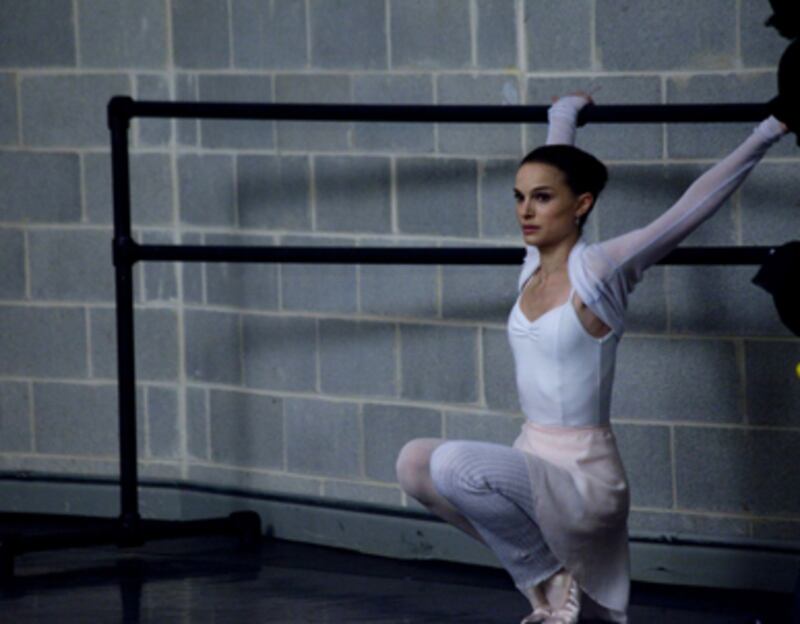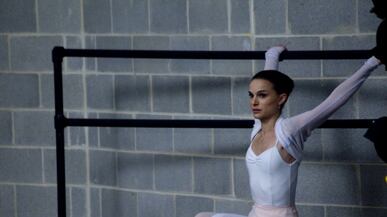I have tried to avoid writing about Darren Aronofsky’s pirouetting parody Black Swan, but, having been a professional ballet dancer for George Balanchine, I keep getting asked what I think of the movie. And now that it has garnered a huge audience, numerous passionate fans and five Oscar nominations, it is time to put on my toe shoes, wrap my ribbons, paint on my four-inch black eyebrows, lace-up my wet-tutu suit and take a grand jeté into Aronofsky’s swamp. I mean lake.

I first saw this film at a screening last November, before it opened to the public. I had high hopes: Aronofsky had done a great deal of homework on the “ballet world,” consulting with many dancers, myself included. Reading the script a year or so previously, I’d been baffled by its reductive simplicity. But, hey, I thought, what do I know about script writing—and Aronofsky and his people seemed like earnest folk.
The film opens with a gorgeous low-lit scene of a ballerina’s beautiful legs and feet ensconced in the shimmering satin sheaths that are the art’s greatest symbol, dancing to the great soaring strains of Tchaikovsky’s passionate score. Oh goody, I thought, I will be swept away by this: the magic, the music, the beauty, the lines, those hypnotizing arched feet that skim the stage on their toes like purring paws (the ballerina was, of course, not the film’s star, Natalie Portman, but her double, Sarah Lane, a real dancer from American Ballet Theatre.)
Unfortunately it proved a terrible tease—the only lyrical moment in a film ostensibly about a lyrical artprior to the onslaught of histrionics that ensue.
One hundred and eight minutes later, as the movie ended, the friend I took—not a dancer—turned to me and asked in all seriousness, “Was that supposed to be camp?” There, on the screen, was a beautiful, bleeding-into-her-tutu Portman as the White Swan, uttering those portentous dying words: “Perfect . . . It was perfect.” As a dancer, I have never been so perfectly insulted.
I had thought when I read those words in the script, this is really stupid simple (the opposite of wicked smart, I would venture), but maybe Aronofsky has one of those things you hear film directors sometimes have: a vision. This was the vision? A dead ballerina in a bloody tutu with the caption “It was perfect”? He could not possibly be basing a film on a ballet dancer—the most fleet, complex, and powerful artist of the physical that exists—and the great 19th-century love story that is Tchaikovsky’s Swan Lake by reducing it to one crazy girl’s addiction to perfection. Or could he? Is this how he sees our art? Like a profession full of self-destructive addicts that need an A&E Intervention, a Dr. Phil “How’s it working for you?” talk, or an Oprah bailout? Aronofsky totally missed—or dismissed—the love story that is the raison d’être of the entire ballet and, instead, myopically latched on like a pit bull (and with the same finesse) to the White Swan/Madonna-Black Swan/whore dichotomy and then delivers his sophomoric dissertation with a sledgehammer. He does, however, clearly delineate his Cygnini discoveries: a White Swan masturbates in white grannie panties, while a Black Swan goes (black) thongless into the night. (Aronofsky clearly has a penchant for mutants: his next film is The Wolverine.)
Black Swan provides the most recent—though most egregious—example of the “ballerinas-are-victims” stance that certain good Samaritans love to embrace (“those dancers are too thin, they are just too too thin”) on occasion to aggrandize themselves, while patronizing those superb creatures whose absolute commitment to excellence they cannot understand. Ballet is the practice of physicalized morality, a poetic standard for every man and woman's ideal capacity," wrote Lincoln Kirstein, who founded the New York City Ballet with Balanchine. To imply that its proponents, dancers, are victims rather than teachers provides swift avoidance of that uncomfortable suggestion. Aronofsky has created a movie celebrating the failure of a ballerina, and by implication her entire art—disguised, insidiously, as a film about sacrifice and success.
As Black Swan so clearly demonstrates, one simply cannot “act” being a ballerina. It is a state of being, of feeling, of mind, an externalized expression of internalized discipline, faith, and good manners.
But I am too harsh. Perhaps Black Swan is simply Aronofsky’s bloody, melodramatic, nonsensical, middle-of-the-road, badly-written bid for box-office success after he tasted its heady brine with the success of the excellent The Wrestler. It could have been such rip-roaring good fun (see Jim Carrey's rendition from Saturday Night Live). And a real nice break from the dull, repetitive, hard work of a true ballerina. But then Black Swan isn’t a film about real ballerinas at all, no more than Jurassic Park is a film about real scientists (or real dinosaurs for that matter)—it merely exploits the locale, the props, and the outerwear. Balletploitation is born.
This brings us to Aronofsky’s heroine: his waify, whiny, bulimic little ballerina, Nina Sayers. Don’t you just love her? The little swan who simply couldn’t fly. And then we hear—over and over —that poor hard-working Natalie Portman had to actually lose weight and work really, really, hard—I mean really hard—for a number of months to pass, barely, as a professional dancer in the film, and only then between her neck and waist (don’t look further down: it isn’t there. Even her double—the one who actually did work really hard for several decades—is hardly on screen). A ballerina without her legs and feet is like a writer without words or a singer without a voice: not one. No wonder Portman looks so beleaguered in the film: she is perhaps the first amputee professional ballerina. But, hey, it’s Hollywood, and she has already won a Golden Globe and will likely garner an Oscar for her dorsal efforts. (Her upper-body-only performance does, however, enable her to wear the first strapless tutus in dance history.)
“The world of ballet,” Portman told French Vogue after making the film “is sick, sick, sick.” Portman, however, has bravely overcome her distaste and is marrying, and reproducing, into the profession all the same. Portman is a lovely actress of considerable accomplishment in other films, but here her one-note earnest angst, denoted by furrowed brow from start to finish, is entirely unlike any real ballerina—a woman who “must have the nobility of a five-star general,” as Agnes de Mille once said—rather than Portman’s insecure little misery. As Black Swan so clearly demonstrates, one simply cannot “act” being a ballerina. It is a state of being, of feeling, of mind, an externalized expression of internalized discipline, faith, and good manners. And of course, one needs those inconvenient legs and feet.
While the result is one almost hilariously sensationalistic movie (Aronofsky even misses being either high or low camp), I have a sneaking suspicion that the director wanted his film, at least in part, to be about the Birth of an Artist. He wants to bludgeon his tutu and wear it too. In straddling his themes—a serious film about the making of an artist, and Psycho at the ballet—he misses both, and flaps around in no swan’s lake.
This, of course, the public is lapping up, especially, I surmise, the vast audience caught in the fangs of vampire love (the Twilight books and movies, True Blood, The Vampire Diaries.) Black Swan has all the same seductive red, white and black elements of blood, innocence, and death delivered with risible solemnity and repressed sexuality. Nosferatu gets a tutu! Besides, there is nothing quite like white feathers and tulle to slowly absorb and spread the blood of a nice deep, suicide stigmata. And what did Nina stab herself with? Oh yes, a shard of her smashed dressing room mirror. I get it, I get it, the mirror murder, death of narcissism by narcissism (the buzzword for those obsessive ballerinas.)
I don’t care in the least that Aronofsky’s depiction of the ballet world and its anxious protagonists uses every blatant cliché about this rarified world, where anorexia, bulimia, self-mutilation, suppressed sexuality (but lots of attempted masturbation!), jealousy, stage mothers from hell, and vulgar, violent, lascivious company directors predominate. And don’t forget the requisite bloody toe close-up. Ewww! (For the record: A bloody toe for a ballerina is like a bruise for a boxer: ho-hum.)
Aronofsky displays neither respect, nor wonder, nor fascination, nor, alas, love for ballet in his film—he sees only half-clad wacko women: all four women in his mutilating misogynistic fetish are uber-crazy chicks. Predictably, he also repeats the truly absurd notion that a young female dancer needs drugs, alcohol, a wild tatooed girlfriend, and pick-up sex to the din of deafening disco music to “loosen up,” to be sexy and alluring on stage. This is a shameless manipulation (hello Hollywood!) to give regular teenage girls a point of connection to those rarified creatures. But the fact remains that reckless, self-destructive girls are simply not the ones who succeed in ballet—they are dropouts who must go to college. Aronofsky did, however, almost win me over with the prospect of skinny crazed lesbian ballerinas in sex scenes with themselves and each other (how else to get men to a movie about ballet?) But even here, the scenes are both passionless and humorless.
Despite all this—or, more likely, because of it—Nina Sayers is the first crazy ballerina to have reached across the elitist wall of the ballet convent into the general public’s awareness, since 1986 when our own bona fide great ballerina Gelsey Kirkland wrote her bestselling memoir Dancing On My Grave (could have been Aronofsky’s title). Kirkland’s real-life drama did include starvation, vomiting, drug addiction, rivals, failed plastic surgery, multiple obsessions, and bad sex with Baryshnikov. (Kirkland was diagnosed by the world-renowned analyst Dr. Otto Kernberg as having borderline personality disorder while under his inpatient care.) Suffice it to say that no real ballerina, Kirkland included, would survive, much less succeed, with such an illness. It is important to note that Kirkland was a very great ballerina before she unraveled—not, sadly, after.
What is even sadder is that the only glimpses of the ballet world that most of the general public sees—and then believes—are these extreme aberrations. I have heard it said of Black Swan’s popularity: “But at least ballet is going on people’s radar.” Better ballet stay off their radar, if so inaccurately represented as a world of insane perfectionists, rather than what it is: a world of masterful devotees to beauty.
Toni Bentley danced with the New York City Ballet for 10 years and is the author of five books including “Winter Season, A Dancer’s Journal” and “The Surrender, An Erotic Memoir.” She is a Guggenheim Fellow, and her story “The Bad Lion” was recently published in “Best American Essays 2010."






